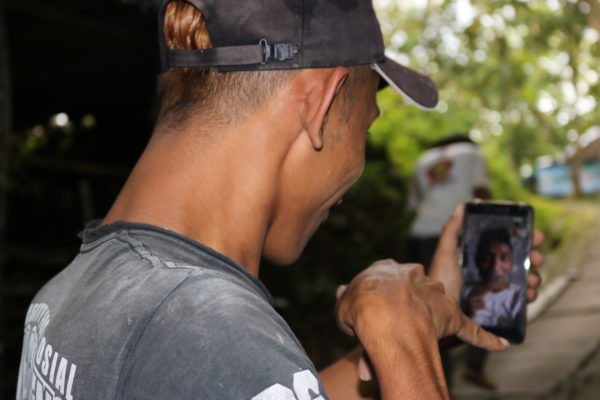By: Erin Moriarty Harrelson
I have been in Indonesia for about four months now, familiarising myself with Bali, tourism in Bali in general, and the nature of deaf tourism here. This involved going on “ride-alongs” with deaf tourist groups, meeting with deaf tourists individually, as well as meeting with community leaders, tourist guides, and village heads, and so forth, to lay the groundwork for our ethnographic film on deaf tourism. I also travelled to Yogyakarta with deaf tourists to observe the phenomenon of “informal” guiding of deaf tourists by deaf people who live in the area.

Photo: One of the men at the Gereja Ayam (“chicken church”) who acted as an informal guide, taking us through the building. He is signing to his phone, chatting with a friend about “the foreigners” who were visiting.
As a part of our tour of the Yogyakarta area by “informal” guides (which I define here as non-professional, often uncompensated guides), we visited the “chicken church”. It is actually supposed to be a dove, but many people think it is a chicken. The most interesting thing about this site was not the oddity of the building itself but the deaf man who materialised at the entrance to the property. He was one of two deaf brothers from a family living nearby. They told us they helped build the church and pointed out younger versions of themselves in the photos displayed in the small exhibition area. At first, I thought it was a coincidence that the deaf tourist group ran into them. Later, I realised that there was a network of deaf people living in this part of Java, communicating via video about the group of foreigners who had shown up. I realised this after observing these men on WhatsApp video with their friends, one who lived next to a small temple, which then became the next destination on the tour.
I also visited “Desa Kolok,” (“deaf village”), a village in north Bali, known for having a high percentage of deaf people and for its shared sign language. On one of my visits, I had the opportunity to observe a crew from a TV station in Japan, who were there doing a documentary on the deaf villagers. The days I spent in the village was an opportunity to observe the impact of tourism (as well as researchers!) on dynamics in the village and the material opportunities these visitors afford the villagers, such as sponsorships for schooling and small donations for the opportunity to chat with them in sign language.

Photo: A television crew from Japan visited the village to film different activities, such as deaf dancers practicing for a performance the next day, a funeral, and a deaf man chopping wood.
It took some time and adjustment, but things seem to have settled into a rhythm, a routine, as much as such a decentralised project can be routine. This project has been challenging logistically, especially because of the lack of a central place where deaf tourists gather, unless you include virtual spaces such as deaf travel discussion groups or deaf networks on Facebook. In this regard, social media, specifically Facebook and Instagram, has been especially helpful for tapping into various deaf networks throughout the world. It was gratifying to see the positive response to a video that I made asking for referrals to deaf tourists who have or will visit Bali and deaf world travellers. People in the deaf network in Australia and the United Kingdom have been especially helpful in this regard.
One of the biggest methodological challenges I have had to face, along with Steve and Amandine in their respective projects, was, how to find people? Admittedly, this was much bigger of a challenge than I had anticipated when I originally designed this project. The methodological challenges of this project arise from the nature of mobility research, especially given the ephemerality of tourism. Most people visit Bali for ten days to two weeks, which means there are less opportunities to spend time embedded with individual tourists on a daily basis as they experience Bali. However, these challenges also mean opportunities for learning about what methodologies work and where. This has meant some adjustments in the field, a common experience for anthropologists! These adjustments included rethinking the practice of ethnography and participant-observation, as well as the heavier use of social media and personal networks as a way of reaching potential research participants.
This project differs from my previous projects because there is not a central place where deaf tourists (and/or guides) congregate in Bali, such as a specific café, NGO, or hotel. Rather, deaf tourist activity in Bali is very decentralised in a physical sense; however, there are two deaf guides in Bali and they both have become nexuses for this project, so to speak. These guides have been extremely generous with their time and introductions. One of the people I often work with is Wahyu Cahyadi, also known as Bali Deaf Guide, who is an institution in Bali, having worked in the tourism industry for over a decade. In fact, I suspect that Wahyu is a destination himself for many deaf tourists! Scheduling a tour with Wahyu is a “must-do”, along with visiting waterfalls and coffee plantations, for many deaf (and hearing signing) tourists who visit Bali. The other person is a deaf man from France who has organized tours for his friends from France, as well as a few other Europeans. These two guides serve very different clienteles, as Wahyu’s customers tend to be from Australia and the United States, however, he has guided several Europeans around Bali. On several occasions, I observed Wahyu employing his vast linguistic repertoire as he communicated with me in ASL and BSL, then with other group members in Auslan or International Sign, as well as in Bahasa Indonesia (spoken Indonesian) to answer questions from curious hearing people about deaf people.

Photo: Wahyu, Bali Deaf Guide, explaining the landscape surrounding Mount Batur, an active volcano on Bali, to two tourists from Europe in International Sign/ASL.
Bali is a large island with a diverse topography and ecology. There is indeed something for everyone in Bali. One of the most interesting aspects of my experience in Bali has been traveling to the different areas where different deaf tourists stay, especially because these various areas all have very distinctive characteristics and cater to specific kinds of tourists, such as beach people, spiritual-seekers, people who come for the spas and massages, and so forth. Indeed, deaf travellers are a diverse group with diverse preferences, which makes sense, because of how diverse deaf people are in general. The most popular places for deaf tourists to stay in Bali seems to be Kuta, Seminyak, and Ubud. These places all have different demographics and “feel”. Some deaf tourists in Bali will move from town to town, such as from Ubud to Seminyak or from Kuta to Ubud. Other tourists will stay in the same town, using these towns as bases for day trips to explore the rest of the island.
The deaf network has been incredibly helpful in terms of identifying participants and introductions to key people, as my experience has been of meeting one person, who then refers me to their acquaintances who are traveling to Bali at a later date, and so on. This was an unexpected but not entirely unsurprising experience. It is a good reminder of how important the concept of networks is for understanding deaf sociality and gatekeeping functions. This was actually a humbling experience, to see how much trust deaf participants—tourist and the touristed—put in me, especially in terms of sharing personal experiences and viewpoints.
I look forward to sharing more with you as this project progresses.







